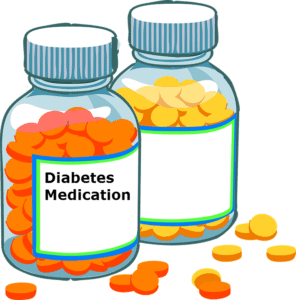Type 2 Diabetes (T2D) is also known, classically, as Diabetes Mellitus and has been known for centuries—even thousands of years. According to the World Health Organization (WHO), a branch of the UN, the number of people with T2D has increased 4 times since 1980, and the prevalence has been rising rapidly. An interesting and likely very important fact is that T2D increases more rapidly in areas where income and living standards has been increasing. The WHO predicts that T2D will be the 7th leading cause of death by 2030.1 In addition, WHO reports that diabetes is a major cause of blindness, heart attacks, kidney failure, stroke and foot/leg amputation—yet, T2D is treatable, manageable and, if caught early enough, potentially reversible!
The Basics
The first “step” in the development of T2D appears to be a condition where cells of the body develop insulin resistance.2 This is a condition where the cells of the body do not respond well to insulin—insulin should be signaling the cells to take up blood sugar, but in insulin resistance, the cells tend to ignore this signal. More and more cells become insulin resistant, causing a rise in blood sugar, and an attempt to compensate by the pancreas. This is a stage of pre-diabetes. Eventually, after likely years of insulin resistance and prediabetes, the end result is T2D with high blood sugar levels and the damage that high blood sugar levels can cause to the nerves and blood vessels of the body.
Causes of T2D
This is not an easy question because there are a number of factors that are clearly involved in T2D and they may play different roles in different people. There are genetic and environmental factors as well and dietary, nutritional and physical activity factors. All these can have a different significance in one individual as compared to another. For example, Asians tend to have a lower Body Mass Index (BMI) when diagnosed with T2D than do those of African or Hispanic descent. Those of African descent tend to have more problems with high blood pressure than other groups diagnosed with T2D. We do however know that eating a healthy diet that is low in processed and industrially produced foods along with a healthy weight and lifestyle including regular exercise significantly lowers the risk that anyone will develop T2D.
Genetics and Environmental Influences
People of different ethnic backgrounds have a higher risk of T2D. These groups include people of African, Hispanic, Native American and some Asian groups. Your genetics can affect how much you weigh, or your tendency to obesity, another risk factor of T2D. Anyone with a parent or a sibling with T2D also has an increased risk.1,2 Environmental influences—that often influence the tendency to obesity that are considered potentially important in the development of T2D include:3
- Endocrine disruptors: Endocrine disruptors are chemicals which interfere with hormonal function. Some are found in nature, but most are man-made. These are found everywhere in our environment and include such substances as phthalates (pronounced thalates), bisphenol A (BPA), phytoestrogens, dioxins and others.
- Sleep is critical for health and many simply don’t get enough sleep or don’t sleep well enough. Studies indicate that loss of a normal sleep cycle plays a role in the development of T2D.4
- Physical activity has decreased in many parts of the world, in part due to various labor-saving technologies as well as other economic and social factors. Children often are not involved in free play times and adults are often hampered by their work schedules and cannot—or feel they cannot—take time out for physical activity.
- Nutrition and the Western Diet. Studies have indicated that when a society adapts the industrialized eating habits of the Western World, called the “Nutrition Transition”, the rates of obesity and T2D begin to rise.5 This may be due in part to the addition of sugar(s) to many processed foods as well as the loss of significant amounts of nutrients as a result of processing. A recent study pointed to the existence of phthalates in many fast foods.6 Many switch to diet soft drinks or sodas, trying to decrease their sugar intake, but research indicates that artificial sweeteners alter the bacteria in the gut—and can in that way increase the risk of diabetes.7
Symptoms of T2D
Symptoms of T2D are classically defined as increased thirst, increased urination, unexplained weight loss and an increased appetite. These, however, are generally later-occurring symptoms. Early on, the only way to determine if you are at a high risk for diabetes is either by a:
- A fasting plasma sugar (glucose) level of greater than or equal to 126 mg/dL (7.0 mmol/L). Prediabetes is diagnosed if the fasting sugar levels are between 100mg/dL and 126mg/dL. For this test, you should only have water for 12 hours before the testing.
OR
- A 2-hour plasma sugar (glucose) level of greater than or equal to 200 mg/dL (11.1 mmol/L) during an oral glucose tolerance test (OGTT). Prediabetes is diagnosed if the OGTT is between 141mg/dL and 199mg/dL.
OR
- A1c levels. To diagnose prediabetes, the A1c is between 5.7% but less than 6.5%. T2D is diagnosed if the A1c is greater than or equal to 6.5 %. The A1c level is commonly used to follow how well an individual is maintaining their control of their blood sugar. The A1c test is measuring a form of hemoglobin—one with sugar molecules attached to it. Since the red blood cells which contain hemoglobin have an average lifespan of about 3 months, and since the percentage of hemoglobin that contains sugars represents how much sugar is in the blood, this test gives a 3 month “snapshot” of blood sugar control.
Complications of T2D
T2D is a chronic disease of sugar regulation and one can think of the complications in this way: since sugar is the main fuel of the cells, disruptions in the control of sugar can disrupt nearly every organ in the body. In addition, high levels of sugar may act as a direct toxin on nerves and blood vessels.8 The main complications of include:
- Cardiovascular disease including risk of heart attacks, coronary artery disease (disease involving the blood vessels that feed the heart), stroke, high blood pressure and narrowing of the arteries (atherosclerosis).
- Nerve damage (neuropathy) that occur most commonly in the legs and feet of individuals with T2D. The tingling, numbness and pain can also extend to the fingers and hands. In men, the nerve damage can lead to erectile dysfunction.
- Kidney damage (nephropathy) occurs because the kidney is made up of millions of tiny filtering units called nephrons. The high levels of glucose that flow through the kidneys are believed to damage these nephrons, leading to kidney damage and eventual possible kidney failure.
- Damage to the retina of the eye (retinopathy) can occur as well as an increased risk of glaucoma and cataracts.
- Increased risk of infections and poor healing can often cause problems in the feet and skin.
- Hearing loss has been associated with T2D
- An increased risk of Alzheimer’s disease, though the connection between T2D and Alzheimer’s disease is not well understood.
Treatment of T2D
Treatment of T2D usually involves a “triad” of approaches, at least. This triad included medications, diet and nutrition and increased physical activity. You will also likely be monitoring your own blood sugar values to make certain they are well controlled.
- Medications:

- Diet and Nutrition:

- Exercise:

Coping with T2D
T2D can be controlled and treated. While getting a diagnosis of T2D may be emotionally difficult, you should try to remember that you have a good deal of control over your diabetes. Getting proactive about the disease can be empowering, and if you control your blood sugar, make any necessary changes in your dietary and exercise habits, you have every chance of enjoying your life to its fullest! It takes knowledge, commitment and dedication, but it CAN be done!
References
- http://www.who.int/mediacentre/factsheets/fs312/en/
- http://diabetes.diabetesjournals.org/content/53/suppl_3/S16.full
- http://www.ncbi.nlm.nih.gov/pmc/articles/PMC2769972/
- Knutson KL, Van Cauter E. Associations between sleep loss and increased risk of obesity and diabetes. Ann N Y Acad Sci. 2008;1129:287–304
- http://care.diabetesjournals.org/content/34/6/1249.full
- http://www.cnn.com/2016/04/15/health/fast-food-phthalates-endocrine-disruptors/
- http://www.nature.com/nature/journal/v514/n7521/full/nature13793.html
- http://www.ncbi.nlm.nih.gov/pmc/articles/PMC2738809/

